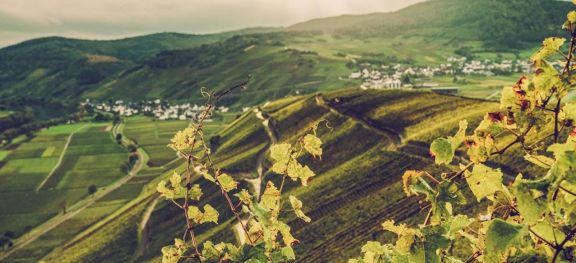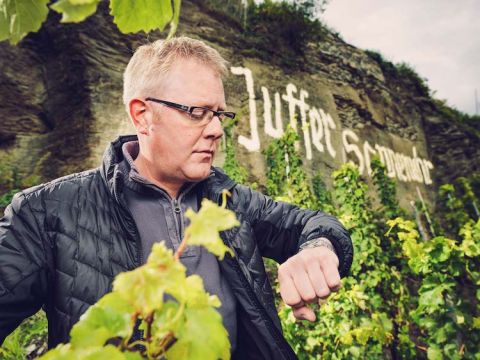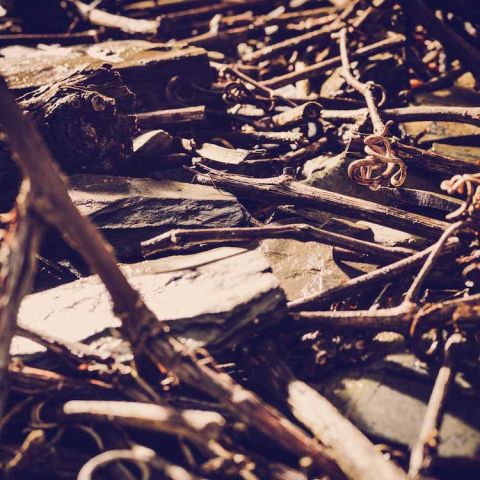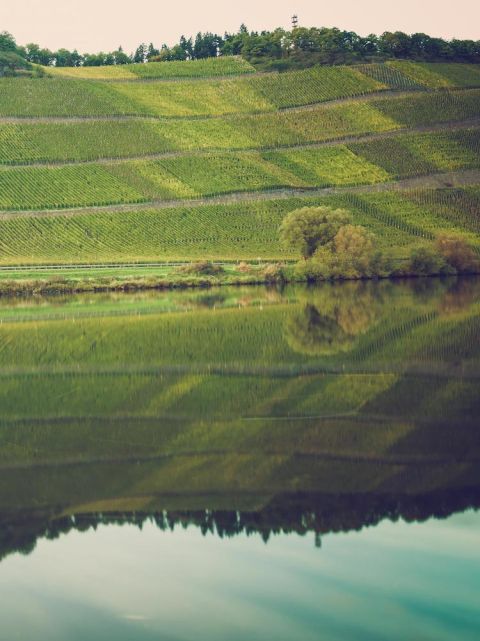Fritz Haag, Brauneberger Riesling Kabinett 2017 Mosel

'Just a simple Kabinett it is not.' From the steep slate slopes of the Mosel comes this delicate, shining star.
From €12.99, £15.07, HK$175, $29
Few producers, in our tasting notes database, can boast an average score of 17 across 230 tasting notes, with nearly half of them 17.5 and above. Fritz Haag has, for decades, been one of the leading lights of the Mosel, and indeed is up there with top wine producers in all of Germany.
The estate has been in the Haag family’s hands since 1605. In 1957 Wilhelm took over the management of the estate, and Gault Millau awarded him ‘German winemaker of the year’ in 1994. He handed over the reins to Oliver in 2005 and today Oliver (pictured below) still runs the estate with his wife Jessica.
They own 16.5 ha (41 acres) of vineyards around the village of Brauneberg, with 6.5 ha (16 acres) and 3 ha (7.5 acres) in the coveted ‘grand cru’ vineyards of Brauneberger Juffer and Brauneberger Juffer Sonnenuhr. All their vineyards are south-facing, on steep slopes and on fine, weathered Devonian slate.
It’s almost impossible to find a description of the estate and its wines that doesn’t include words such as legendary, top tier, elegance, greatness, finest, pedigree, unmatchable. So, it’s all the more astounding that one can pick up a bottle of their wine for £15. Sure, this is an Ortswein (village wine), but it delivers well above what one would expect for an ‘everyday’ village wine. There is every bit as much pleasure in every ounce of the open, whole-hearted, racy, lacy charm of this wine as you would find in any of their more glamorous Grosse Lage wines.
Oliver Haag vinifies with spontaneous fermentation in a mix of wooden fuders and temperature-controlled stainless-steel tanks. Alcohol is just 8.5% and although residual sugar is 45 g/l, the finish is effortlessly fresh and dry.
My tasting note went: ‘There’s a charming, sweet dustiness to the nose of this wine – as if someone had dried ripe apple slices pressed between old cedar planks and then blitzed the apples into a fine powder. But on the palate, it’s all lime-dipped late-harvest apples and pears. Remarkable purity. Translucent clarity of purpose and direction. It feels as if it’s swimming through a pool of clear liquid glass; reaches the edge, somersaults and glides back. It is, to be quite frank, damn delicious. It’s zimming* with energy and life, as if every mouthful has been buzzed by a tiny electric current. I could drink this every day of my life and never tire of it. VVGV’
*A made-up word – zesty + brimming.
And very, very good value it most certainly is. Michael Schmidt actually gave the wine a whopping score of 18, saying that, ‘It almost takes your breath away only to come back with a cool, lingering vibrancy. A hint of mint reflects the use of ambient yeasts. Just a simple village Kabinett it is not!’ He suggests that the wine has a drinking window of 2018 to 2030, which is quite remarkable for a £15 wine. You could easily snap up a case of this and drink the bottles over a decade.
You can find the wine in Germany, the Netherlands, Hong Kong and both the UK and the US (IN, FL). Other vintages, from 2016 to 2020 (which will be just as reliable and delicious), are also available in the US (DC, NY, CT and NC) as well as Taiwan. In the UK, the best price seems to be at Justerini & Brooks, but it’s also available through Christopher Keiller Fine Wine Services, Wine Direct (Sussex) and Voyageurs du Vin. Justincases is selling the 2018.
Michael Schmidt described 2017 in Germany as a record-breaking vintage – for more on this vintage, take a look at our Germany 2017 coverage guide.
Become a member to view this article and thousands more!
- 15,414 featured articles
- 275,126 wine reviews
- Maps from The World Atlas of Wine, 8th edition (RRP £50)
- The Oxford Companion to Wine, 5th edition (RRP £50)
- Members’ forum
- 15,414 featured articles
- 275,126 wine reviews
- Maps from The World Atlas of Wine, 8th edition (RRP £50)
- The Oxford Companion to Wine, 5th edition (RRP £50)
- Members’ forum
- 48-hour preview of all scheduled articles
- Commercial use of our wine reviews




